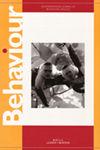颜色,位置和运动:关于东亚马逊地区毒蛙颜色变化的捕食模型告诉我们什么?
IF 1
4区 生物学
Q4 BEHAVIORAL SCIENCES
引用次数: 0
摘要
众所周知,许多树状蛙是一种象征:颜色鲜艳,捕食者不喜欢。为了欺骗捕食者,用于测试捕食者颜色偏见的青蛙模型必须在大小、颜色、形状和运动方面与青蛙相似。我们在两个地方用半乳疏脂菌的移动模型进行了一项实验。半乳蛙是一种多型蛙,每个种群都有不同的颜色。鸟类和哺乳动物是造成模型上标记的脊椎动物,但对局部、非局部和神秘颜色模型的攻击频率没有差异。只有无脊椎动物避开了神秘的模型。该物种的不同种群似乎受到不同的捕食压力,但该物种的颜色分化可能与其他机制有关,如性选择。本文章由计算机程序翻译,如有差异,请以英文原文为准。
Colour, location and movement: what do models tell us about predation on colour morphs of a poison frog from eastern Amazonia?
Many dendrobatid frogs are known to be aposematic: brightly coloured and unpalatable to predators. To deceive predators, frog models used to test for predatory colour bias must be similar in size, colour, shape, and movement to frogs. We carried out an experiment with moving models of the species Adelphobates galactonotus, in two localities. A. galactonotus is a polytypic frog and each population of the species has a distinct colour. Birds and mammals were the vertebrates responsible for the marks on the models, but there was no difference in frequency of attacks on local-, non-local- and cryptic-colour models. Only invertebrates avoided cryptic models. Different populations of the species seem to be under different predation pressure, but colour differentiation in this species is probably related to other mechanisms, such as sexual selection.
求助全文
通过发布文献求助,成功后即可免费获取论文全文。
去求助
来源期刊

Behaviour
生物-动物学
CiteScore
1.80
自引率
7.70%
发文量
44
审稿时长
3 months
期刊介绍:
Behaviour is interested in all aspects of animal (including human) behaviour, from ecology and physiology to learning, cognition, and neuroscience. Evolutionary approaches, which concern themselves with the advantages of behaviour or capacities for the organism and its reproduction, receive much attention both at a theoretical level and as it relates to specific behavior.
 求助内容:
求助内容: 应助结果提醒方式:
应助结果提醒方式:


